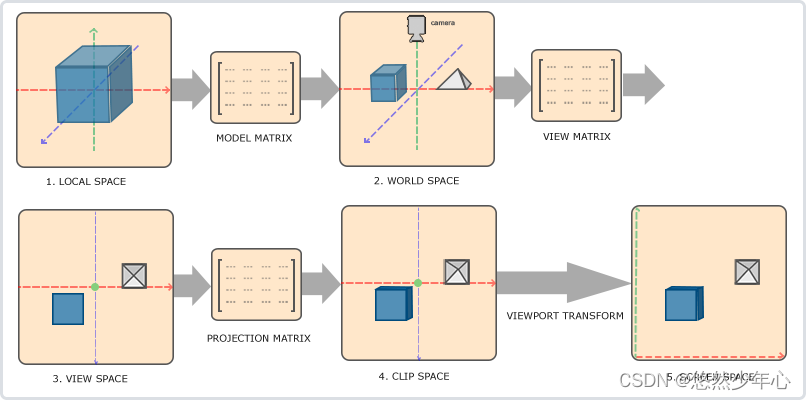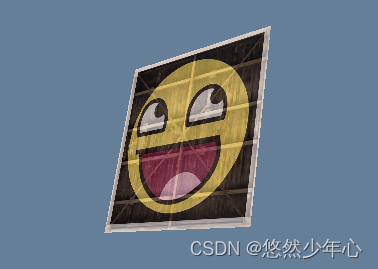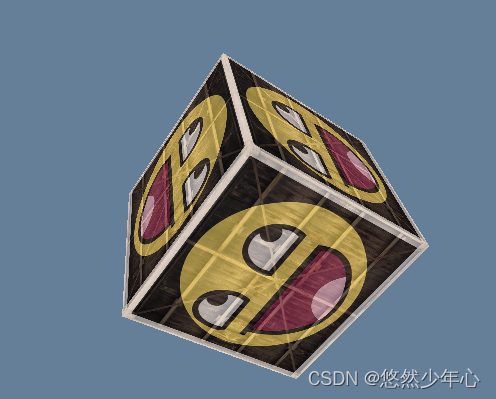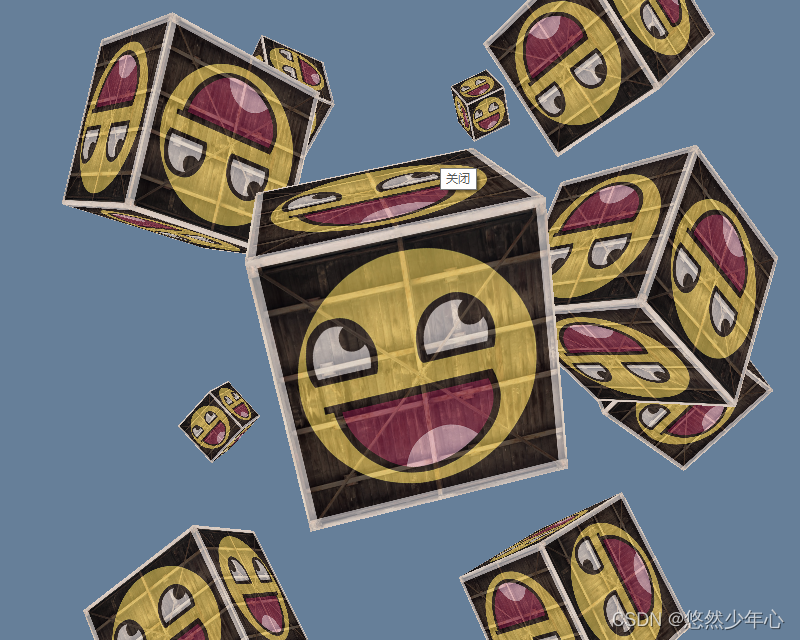这一节对shader类添加了一些函数
在顶点坐标里面使用model view projection变换
需要依次乘以model view projection矩阵注意矩阵的连续乘法是从右到左结合的
各个变换空间:

glm::mat4 model = glm::mat4(1.0f);//定义一个单位矩阵
projection = glm::perspective(glm::radians(45.0f), (float)SCR_WIDTH / (float)SCR_HEIGHT, 0.1f, 100.0f);
//perspective透视矩阵:第一个是参数视场角大小,第二个参数是高宽比,第三个参数是near和far
view = glm::translate(view, glm::vec3(0.0f, 0.0f, -3.0f));
//这个view实际上是你看到物体的矩阵
//可以通过调整XYZ轴的数值来调节你的相机位置
model = glm::rotate(model, glm::radians(-55.0f), glm::vec3(1.0f, 0.0f, 0.0f));
//第二个参数旋转角度,第三个参数是旋转轴分别对应XYZ 只有X为1表示围绕X轴旋转
model = glm::rotate(model, (float)glfwGetTime() * glm::radians(50.0f), glm::vec3(0.5f, 1.0f, 0.0f));
//旋转角度等于时间(每秒)*50度然后围绕xy轴旋转
glEnable(GL_DEPTH_TEST);//开启深度测试就会得到一个深度信息
// OpenGL存储深度信息在一个叫做Z缓冲(Z-buffer)的缓冲中它允许OpenGL决定何时覆盖一个像素而何时不覆盖。通过使用Z缓冲,我们可以配置OpenGL来进行深度测试。
//深度值存储在每个片段里面(作为片段的z值),当片段想要输出它的颜色时,OpenGL会将它的深度值和z缓冲进行比较,如果当前的片段在其它片段之后,它将会被丢弃,否则将会覆盖。这
//个过程称为深度测试(Depth Testing),它是由OpenGL自动完成的。
取时间*旋转角:

gl_Position =projection*view*model*vec4(aPos, 1.0);
//shader类 头文件多了一个glm库参考上一节可以使用
#include <glad/glad.h>
#include <string>
#include <fstream>
#include <sstream>
#include <iostream>
#include <glad/glad.h>
#include <glm/glm.hpp>
//#include "stb_image.h"
class Shader
{
public:
unsigned int ID;
//构造着色器类
// ------------------------------------------------------------------------
Shader(const char* vertexPath, const char* fragmentPath)
{
// 1. 从文件路径中获得着色器
std::string vertexCode;
std::string fragmentCode;
std::ifstream vShaderFile;
std::ifstream fShaderFile;
// 确保ifstream对象可以抛出异常:
vShaderFile.exceptions(std::ifstream::failbit | std::ifstream::badbit);
fShaderFile.exceptions(std::ifstream::failbit | std::ifstream::badbit);
try
{
// 打开文件
vShaderFile.open(vertexPath);
fShaderFile.open(fragmentPath);
std::stringstream vShaderStream, fShaderStream;
// 读取文件的缓冲内容到数据流中
vShaderStream << vShaderFile.rdbuf();
fShaderStream << fShaderFile.rdbuf();
// 关闭文件处理器
vShaderFile.close();
fShaderFile.close();
// 转换数据流到string
vertexCode = vShaderStream.str();
fragmentCode = fShaderStream.str();
}
catch (std::ifstream::failure& e)
{
std::cout << "ERROR::SHADER::FILE_NOT_SUCCESFULLY_READ: " << e.what() << std::endl;
}
const char* vShaderCode = vertexCode.c_str();
const char* fShaderCode = fragmentCode.c_str();
// 2. 编译着色器
unsigned int vertex, fragment;
// vertex shader
vertex = glCreateShader(GL_VERTEX_SHADER);
glShaderSource(vertex, 1, &vShaderCode, NULL);
glCompileShader(vertex);
checkCompileErrors(vertex, "VERTEX");
// fragment Shader
fragment = glCreateShader(GL_FRAGMENT_SHADER);
glShaderSource(fragment, 1, &fShaderCode, NULL);
glCompileShader(fragment);
checkCompileErrors(fragment, "FRAGMENT");
// shader Program
ID = glCreateProgram();
glAttachShader(ID, vertex);
glAttachShader(ID, fragment);
glLinkProgram(ID);
checkCompileErrors(ID, "PROGRAM");
// 链接成功之后删除
glDeleteShader(vertex);
glDeleteShader(fragment);
}
// 激活着色
// ------------------------------------------------------------------------
void use()
{
glUseProgram(ID);
}
// uniform函数 glGetUniformLocation(ID, name.c_str())吧ID和着色器上要用的uniform名字传进去得到一个location
// glUniform1i()第一个参数就是这个location 第四个参数就是这个数组的引用就是这个矩阵或者向量 相当于把这个矩阵赋值给uniform
// ------------------------------------------------------------------------
void setBool(const std::string& name, bool value) const
{
glUniform1i(glGetUniformLocation(ID, name.c_str()), (int)value);
}
// ------------------------------------------------------------------------
void setInt(const std::string& name, int value) const
{
glUniform1i(glGetUniformLocation(ID, name.c_str()), value);
}
// ------------------------------------------------------------------------
void setFloat(const std::string& name, float value) const
{
glUniform1f(glGetUniformLocation(ID, name.c_str()), value);
}
// ------------------------------------------------------------------------
void setVec2(const std::string& name, const glm::vec2& value) const
{
glUniform2fv(glGetUniformLocation(ID, name.c_str()), 1, &value[0]);
}
void setVec2(const std::string& name, float x, float y) const
{
glUniform2f(glGetUniformLocation(ID, name.c_str()), x, y);
}
// ------------------------------------------------------------------------
void setVec3(const std::string& name, const glm::vec3& value) const
{
glUniform3fv(glGetUniformLocation(ID, name.c_str()), 1, &value[0]);
}
void setVec3(const std::string& name, float x, float y, float z) const
{
glUniform3f(glGetUniformLocation(ID, name.c_str()), x, y, z);
}
// ------------------------------------------------------------------------
void setVec4(const std::string& name, const glm::vec4& value) const
{
glUniform4fv(glGetUniformLocation(ID, name.c_str()), 1, &value[0]);
}
void setVec4(const std::string& name, float x, float y, float z, float w)
{
glUniform4f(glGetUniformLocation(ID, name.c_str()), x, y, z, w);
}
// ------------------------------------------------------------------------
void setMat2(const std::string& name, const glm::mat2& mat) const
{
glUniformMatrix2fv(glGetUniformLocation(ID, name.c_str()), 1, GL_FALSE, &mat[0][0]);
}
// ------------------------------------------------------------------------
void setMat3(const std::string& name, const glm::mat3& mat) const
{
glUniformMatrix3fv(glGetUniformLocation(ID, name.c_str()), 1, GL_FALSE, &mat[0][0]);
}
// ------------------------------------------------------------------------
void setMat4(const std::string& name, const glm::mat4& mat) const
{
glUniformMatrix4fv(glGetUniformLocation(ID, name.c_str()), 1, GL_FALSE, &mat[0][0]);
}
private:
// 检查是否链接成功
// ------------------------------------------------------------------------
void checkCompileErrors(unsigned int shader, std::string type)
{
int success;
char infoLog[1024];
if (type != "PROGRAM")
{
glGetShaderiv(shader, GL_COMPILE_STATUS, &success);
if (!success)
{
glGetShaderInfoLog(shader, 1024, NULL, infoLog);
std::cout << "ERROR::SHADER_COMPILATION_ERROR of type: " << type << "n" << infoLog << "n -- --------------------------------------------------- -- " << std::endl;
}
}
else
{
glGetProgramiv(shader, GL_LINK_STATUS, &success);
if (!success)
{
glGetProgramInfoLog(shader, 1024, NULL, infoLog);
std::cout << "ERROR::PROGRAM_LINKING_ERROR of type: " << type << "n" << infoLog << "n -- --------------------------------------------------- -- " << std::endl;
}
}
}
};
这里主要初次定义了三个矩阵并且作为着色器的uniform来使用
//坐标系统
#include "Shader.h"
#include <GLFW/glfw3.h>
#include <glad/glad.h>
#include<iostream>
#define STB_IMAGE_IMPLEMENTATION
#include "stb_image.h"
#include <glm/glm.hpp>
#include <glm/gtc/matrix_transform.hpp>
#include <glm/gtc/type_ptr.hpp>
const unsigned int SCR_WIDTH = 800;
const unsigned int SCR_HEIGHT = 600;
float vertices[] = {
// positions // texture coords
0.5f, 0.5f, 0.0f, 1.0f, 1.0f, // top right
0.5f, -0.5f, 0.0f, 1.0f, 0.0f, // bottom right
-0.5f, -0.5f, 0.0f, 0.0f, 0.0f, // bottom left
-0.5f, 0.5f, 0.0f, 0.0f, 1.0f // top left
};
unsigned int indices[] = {
0, 1, 3, // 第一个三角形
1, 2, 3 // 第二个三角形
};
void processInput(GLFWwindow* window)
{
if (glfwGetKey(window, GLFW_KEY_ESCAPE) == GLFW_PRESS)
glfwSetWindowShouldClose(window, true);
//这里我们检查用户是否按下了返回键(Esc)
}
int main(void)
{
//必须先初始化该库,然后才能使用大多数GLFW函数。成功初始化后,GLFW_TRUE将返回。如果发生错误,GLFW_FALSE则返回。
if (!glfwInit())
return -1;
//创建窗口(OpenGL上下文似乎也一并创建了)
GLFWwindow* window = glfwCreateWindow(640, 480, "Hello World", NULL, NULL);
//glfwCreateWindow函数需要窗口的宽和高作为它的前两个参数。第三个参数表示这个窗口的名称(标题
if (!window)
{
glfwTerminate();
return -1;
}
/* Make the window's context current */
glfwMakeContextCurrent(window);
//使用GLAD来加载OpenGL的函数地址 GLAD是用来管理OpenGL的函数指针的,所以在调用任何OpenGL的函数之前我们需要初始化GLAD。
//我们给GLAD传入了用来加载系统相关的OpenGL函数指针地址的函数。GLFW给我们的是glfwGetProcAddress,它根据我们编译的系统定义了正确的函数。
gladLoadGL();
if (!gladLoadGLLoader((GLADloadproc)glfwGetProcAddress))
{
std::cout << "Failed to initialize GLAD" << std::endl;
return -1;
}
Shader ourShader("shaderSampler.vs", "shaderSampler.fs");
//如果要绘制两个三角形就需要使用索引缓存对象来告诉GPU使用哪些顶点
unsigned int VAO, VBO, EBO;
glGenVertexArrays(1, &VAO);//glGenVertexArrays来创建顶点数组
glGenBuffers(1, &VBO);//glGenBuffers来创建缓存
glGenBuffers(1, &EBO);
glBindVertexArray(VAO);//为下面的属性绑定VAO
glBindBuffer(GL_ARRAY_BUFFER, VBO); //OpenGL有很多缓冲对象类型,顶点缓冲对象的缓冲类型是GL_ARRAY_BUFFER。
glBufferData(GL_ARRAY_BUFFER, sizeof(vertices), vertices, GL_STATIC_DRAW);//绑定顶点并把顶点发送给GPU 第三个参数就是我们希望发送的实际数据。
glBindBuffer(GL_ELEMENT_ARRAY_BUFFER, EBO);
glBufferData(GL_ELEMENT_ARRAY_BUFFER, sizeof(indices), indices, GL_STATIC_DRAW);
glVertexAttribPointer(0, 3, GL_FLOAT, GL_FALSE, 5 * sizeof(float), (void*)0);
glEnableVertexAttribArray(0);
glVertexAttribPointer(1, 2, GL_FLOAT, GL_FALSE, 5 * sizeof(float), (void*)(3 * sizeof(float)));
glEnableVertexAttribArray(1);
// 加载并生成纹理
unsigned int texture1, texture2;
glGenTextures(1, &texture1);
glBindTexture(GL_TEXTURE_2D, texture1);
// set the texture wrapping parameters
glTexParameteri(GL_TEXTURE_2D, GL_TEXTURE_WRAP_S, GL_REPEAT); // set texture wrapping to GL_REPEAT (default wrapping method)
glTexParameteri(GL_TEXTURE_2D, GL_TEXTURE_WRAP_T, GL_REPEAT);
// set texture filtering parameters
glTexParameteri(GL_TEXTURE_2D, GL_TEXTURE_MIN_FILTER, GL_LINEAR);
glTexParameteri(GL_TEXTURE_2D, GL_TEXTURE_MAG_FILTER, GL_LINEAR);
int width, height, nrChannels;
//stbi_set_flip_vertically_on_load(true);//告诉stb_image.h翻转Y轴上加载的纹理。
unsigned char* data = stbi_load("container.jpg", &width, &height, &nrChannels, 0);
if (data)
{
glTexImage2D(GL_TEXTURE_2D, 0, GL_RGB, width, height, 0, GL_RGB, GL_UNSIGNED_BYTE, data);
glGenerateMipmap(GL_TEXTURE_2D);
}
else
{
std::cout << "Failed to load texture" << std::endl;
}
stbi_image_free(data);
glGenTextures(1, &texture2);
glBindTexture(GL_TEXTURE_2D, texture2);
// set the texture wrapping parameters
glTexParameteri(GL_TEXTURE_2D, GL_TEXTURE_WRAP_S, GL_REPEAT); // set texture wrapping to GL_REPEAT (default wrapping method)
glTexParameteri(GL_TEXTURE_2D, GL_TEXTURE_WRAP_T, GL_REPEAT);
// set texture filtering parameters
glTexParameteri(GL_TEXTURE_2D, GL_TEXTURE_MIN_FILTER, GL_LINEAR);
glTexParameteri(GL_TEXTURE_2D, GL_TEXTURE_MAG_FILTER, GL_LINEAR);
stbi_set_flip_vertically_on_load(true);
data = stbi_load("awesomeface.png", &width, &height, &nrChannels, 0);
if (data)
{
glTexImage2D(GL_TEXTURE_2D, 0, GL_RGBA, width, height, 0, GL_RGBA, GL_UNSIGNED_BYTE, data);
glGenerateMipmap(GL_TEXTURE_2D);
}
else
{
std::cout << "Failed to load texture" << std::endl;
}
stbi_image_free(data);
ourShader.use(); // 不要忘记在设置uniform变量之前激活着色器程序!
ourShader.setInt("texture1", 0);
ourShader.setInt("texture2", 1);
//循环直到用户关闭窗口 渲染循环(Render Loop),它能在我们让GLFW退出前一直保持运行
while (!glfwWindowShouldClose(window))
{
processInput(window);//使用按键
//清理屏幕所用的颜色:
glClearColor(0.4f, 0.5f, 0.6f, 1.0f);
//清理屏幕 它接受一个缓冲位(Buffer Bit)来指定要清空的缓冲,
//可能的缓冲位有GL_COLOR_BUFFER_BIT,GL_DEPTH_BUFFER_BIT和GL_STENCIL_BUFFER_BIT。由于现在我们只关心颜色值,所以我们只清空颜色缓冲。
glClear(GL_COLOR_BUFFER_BIT);
// bind textures on corresponding texture units
glActiveTexture(GL_TEXTURE0);
glBindTexture(GL_TEXTURE_2D, texture1);
glActiveTexture(GL_TEXTURE1);
glBindTexture(GL_TEXTURE_2D, texture2);
ourShader.use();
glm::mat4 model = glm::mat4(1.0f);
glm::mat4 view = glm::mat4(1.0f);
glm::mat4 projection = glm::mat4(1.0f);
projection = glm::perspective(glm::radians(45.0f), (float)SCR_WIDTH / (float)SCR_HEIGHT, 0.1f, 100.0f);
view = glm::translate(view, glm::vec3(0.0f, 0.0f, -3.0f));
model = glm::rotate(model, glm::radians(-55.0f), glm::vec3(1.0f, 0.0f, 0.0f));
ourShader.setMat4("model", model);//这里第一个参数里面model着色器里面uniform的名字,第二个参数model是这个矩阵
ourShader.setMat4("view", view);
ourShader.setMat4("projection", projection);
glBindVertexArray(VAO);
glDrawElements(GL_TRIANGLES, 6, GL_UNSIGNED_INT, 0);
//交换前后缓冲
glfwSwapBuffers(window);
//轮询并处理事件
glfwPollEvents();
}
glDeleteVertexArrays(1, &VAO);
glDeleteBuffers(1, &VBO);
//使用GLFW完成操作后,通常是在应用程序退出之前,需要终止GLFW 释放/删除之前的分配的所有资源
glfwTerminate();
return 0;
}
//矩阵进行变换
#include "Shader.h"
#include <GLFW/glfw3.h>
#include <glad/glad.h>
#include<iostream>
#define STB_IMAGE_IMPLEMENTATION
#include "stb_image.h"
#include <glm/glm.hpp>
#include <glm/gtc/matrix_transform.hpp>
#include <glm/gtc/type_ptr.hpp>
const unsigned int SCR_WIDTH = 800;
const unsigned int SCR_HEIGHT = 600;
//float vertices[] = {
// // positions // texture coords
// 0.5f, 0.5f, 0.0f, 1.0f, 1.0f, // top right
// 0.5f, -0.5f, 0.0f, 1.0f, 0.0f, // bottom right
// -0.5f, -0.5f, 0.0f, 0.0f, 0.0f, // bottom left
// -0.5f, 0.5f, 0.0f, 0.0f, 1.0f // top left
//};
//unsigned int indices[] = {
// 0, 1, 3, // 第一个三角形
// 1, 2, 3 // 第二个三角形
//};
float vertices[] = {
-0.5f, -0.5f, -0.5f, 0.0f, 0.0f,
0.5f, -0.5f, -0.5f, 1.0f, 0.0f,
0.5f, 0.5f, -0.5f, 1.0f, 1.0f,
0.5f, 0.5f, -0.5f, 1.0f, 1.0f,
-0.5f, 0.5f, -0.5f, 0.0f, 1.0f,
-0.5f, -0.5f, -0.5f, 0.0f, 0.0f,
-0.5f, -0.5f, 0.5f, 0.0f, 0.0f,
0.5f, -0.5f, 0.5f, 1.0f, 0.0f,
0.5f, 0.5f, 0.5f, 1.0f, 1.0f,
0.5f, 0.5f, 0.5f, 1.0f, 1.0f,
-0.5f, 0.5f, 0.5f, 0.0f, 1.0f,
-0.5f, -0.5f, 0.5f, 0.0f, 0.0f,
-0.5f, 0.5f, 0.5f, 1.0f, 0.0f,
-0.5f, 0.5f, -0.5f, 1.0f, 1.0f,
-0.5f, -0.5f, -0.5f, 0.0f, 1.0f,
-0.5f, -0.5f, -0.5f, 0.0f, 1.0f,
-0.5f, -0.5f, 0.5f, 0.0f, 0.0f,
-0.5f, 0.5f, 0.5f, 1.0f, 0.0f,
0.5f, 0.5f, 0.5f, 1.0f, 0.0f,
0.5f, 0.5f, -0.5f, 1.0f, 1.0f,
0.5f, -0.5f, -0.5f, 0.0f, 1.0f,
0.5f, -0.5f, -0.5f, 0.0f, 1.0f,
0.5f, -0.5f, 0.5f, 0.0f, 0.0f,
0.5f, 0.5f, 0.5f, 1.0f, 0.0f,
-0.5f, -0.5f, -0.5f, 0.0f, 1.0f,
0.5f, -0.5f, -0.5f, 1.0f, 1.0f,
0.5f, -0.5f, 0.5f, 1.0f, 0.0f,
0.5f, -0.5f, 0.5f, 1.0f, 0.0f,
-0.5f, -0.5f, 0.5f, 0.0f, 0.0f,
-0.5f, -0.5f, -0.5f, 0.0f, 1.0f,
-0.5f, 0.5f, -0.5f, 0.0f, 1.0f,
0.5f, 0.5f, -0.5f, 1.0f, 1.0f,
0.5f, 0.5f, 0.5f, 1.0f, 0.0f,
0.5f, 0.5f, 0.5f, 1.0f, 0.0f,
-0.5f, 0.5f, 0.5f, 0.0f, 0.0f,
-0.5f, 0.5f, -0.5f, 0.0f, 1.0f
};
void processInput(GLFWwindow* window)
{
if (glfwGetKey(window, GLFW_KEY_ESCAPE) == GLFW_PRESS)
glfwSetWindowShouldClose(window, true);
//这里我们检查用户是否按下了返回键(Esc)
}
int main(void)
{
//必须先初始化该库,然后才能使用大多数GLFW函数。成功初始化后,GLFW_TRUE将返回。如果发生错误,GLFW_FALSE则返回。
if (!glfwInit())
return -1;
//创建窗口(OpenGL上下文似乎也一并创建了)
GLFWwindow* window = glfwCreateWindow(640, 480, "Hello World", NULL, NULL);
//glfwCreateWindow函数需要窗口的宽和高作为它的前两个参数。第三个参数表示这个窗口的名称(标题
if (!window)
{
glfwTerminate();
return -1;
}
/* Make the window's context current */
glfwMakeContextCurrent(window);
//使用GLAD来加载OpenGL的函数地址 GLAD是用来管理OpenGL的函数指针的,所以在调用任何OpenGL的函数之前我们需要初始化GLAD。
//我们给GLAD传入了用来加载系统相关的OpenGL函数指针地址的函数。GLFW给我们的是glfwGetProcAddress,它根据我们编译的系统定义了正确的函数。
gladLoadGL();
if (!gladLoadGLLoader((GLADloadproc)glfwGetProcAddress))
{
std::cout << "Failed to initialize GLAD" << std::endl;
return -1;
}
Shader ourShader("shaderSampler.vs", "shaderSampler.fs");
//如果要绘制两个三角形就需要使用索引缓存对象来告诉GPU使用哪些顶点
unsigned int VAO, VBO, EBO;
glGenVertexArrays(1, &VAO);//glGenVertexArrays来创建顶点数组
glGenBuffers(1, &VBO);//glGenBuffers来创建缓存
glGenBuffers(1, &EBO);
glBindVertexArray(VAO);//为下面的属性绑定VAO
glBindBuffer(GL_ARRAY_BUFFER, VBO); //OpenGL有很多缓冲对象类型,顶点缓冲对象的缓冲类型是GL_ARRAY_BUFFER。
glBufferData(GL_ARRAY_BUFFER, sizeof(vertices), vertices, GL_STATIC_DRAW);//绑定顶点并把顶点发送给GPU 第三个参数就是我们希望发送的实际数据。
/* glBindBuffer(GL_ELEMENT_ARRAY_BUFFER, EBO);
glBufferData(GL_ELEMENT_ARRAY_BUFFER, sizeof(indices), indices, GL_STATIC_DRAW);*/
glVertexAttribPointer(0, 3, GL_FLOAT, GL_FALSE, 5 * sizeof(float), (void*)0);
glEnableVertexAttribArray(0);
glVertexAttribPointer(1, 2, GL_FLOAT, GL_FALSE, 5 * sizeof(float), (void*)(3 * sizeof(float)));
glEnableVertexAttribArray(1);
// 加载并生成纹理
unsigned int texture1, texture2;
glGenTextures(1, &texture1);
glBindTexture(GL_TEXTURE_2D, texture1);
// set the texture wrapping parameters
glTexParameteri(GL_TEXTURE_2D, GL_TEXTURE_WRAP_S, GL_REPEAT); // set texture wrapping to GL_REPEAT (default wrapping method)
glTexParameteri(GL_TEXTURE_2D, GL_TEXTURE_WRAP_T, GL_REPEAT);
// set texture filtering parameters
glTexParameteri(GL_TEXTURE_2D, GL_TEXTURE_MIN_FILTER, GL_LINEAR);
glTexParameteri(GL_TEXTURE_2D, GL_TEXTURE_MAG_FILTER, GL_LINEAR);
int width, height, nrChannels;
//stbi_set_flip_vertically_on_load(true);//告诉stb_image.h翻转Y轴上加载的纹理。
unsigned char* data = stbi_load("container.jpg", &width, &height, &nrChannels, 0);
if (data)
{
glTexImage2D(GL_TEXTURE_2D, 0, GL_RGB, width, height, 0, GL_RGB, GL_UNSIGNED_BYTE, data);
glGenerateMipmap(GL_TEXTURE_2D);
}
else
{
std::cout << "Failed to load texture" << std::endl;
}
stbi_image_free(data);
glGenTextures(1, &texture2);
glBindTexture(GL_TEXTURE_2D, texture2);
// set the texture wrapping parameters
glTexParameteri(GL_TEXTURE_2D, GL_TEXTURE_WRAP_S, GL_REPEAT); // set texture wrapping to GL_REPEAT (default wrapping method)
glTexParameteri(GL_TEXTURE_2D, GL_TEXTURE_WRAP_T, GL_REPEAT);
// set texture filtering parameters
glTexParameteri(GL_TEXTURE_2D, GL_TEXTURE_MIN_FILTER, GL_LINEAR);
glTexParameteri(GL_TEXTURE_2D, GL_TEXTURE_MAG_FILTER, GL_LINEAR);
stbi_set_flip_vertically_on_load(true);
data = stbi_load("awesomeface.png", &width, &height, &nrChannels, 0);
if (data)
{
glTexImage2D(GL_TEXTURE_2D, 0, GL_RGBA, width, height, 0, GL_RGBA, GL_UNSIGNED_BYTE, data);
glGenerateMipmap(GL_TEXTURE_2D);
}
else
{
std::cout << "Failed to load texture" << std::endl;
}
stbi_image_free(data);
glEnable(GL_DEPTH_TEST);//开启深度测试
ourShader.use(); // 不要忘记在设置uniform变量之前激活着色器程序!
ourShader.setInt("texture1", 0);
ourShader.setInt("texture2", 1);
//循环直到用户关闭窗口 渲染循环(Render Loop),它能在我们让GLFW退出前一直保持运行
while (!glfwWindowShouldClose(window))
{
processInput(window);//使用按键
//清理屏幕所用的颜色:
glClearColor(0.4f, 0.5f, 0.6f, 1.0f);
//清理屏幕 它接受一个缓冲位(Buffer Bit)来指定要清空的缓冲,
//可能的缓冲位有GL_COLOR_BUFFER_BIT,GL_DEPTH_BUFFER_BIT和GL_STENCIL_BUFFER_BIT。由于现在我们只关心颜色值,所以我们只清空颜色缓冲。
glClear(GL_COLOR_BUFFER_BIT| GL_DEPTH_BUFFER_BIT);
// bind textures on corresponding texture units
glActiveTexture(GL_TEXTURE0);
glBindTexture(GL_TEXTURE_2D, texture1);
glActiveTexture(GL_TEXTURE1);
glBindTexture(GL_TEXTURE_2D, texture2);
ourShader.use();
glm::mat4 model = glm::mat4(1.0f);
glm::mat4 view = glm::mat4(1.0f);
glm::mat4 projection = glm::mat4(1.0f);
projection = glm::perspective(glm::radians(45.0f), (float)SCR_WIDTH / (float)SCR_HEIGHT, 0.1f, 100.0f);
view = glm::translate(view, glm::vec3(0.0f, 0.0f, -3.0f));
model = glm::rotate(model, (float)glfwGetTime() * glm::radians(50.0f), glm::vec3(0.5f, 1.0f, 0.0f));//旋转角度等于时间(每秒)*50度然后围绕xy轴旋转
// model = glm::rotate(model, glm::radians(-55.0f), glm::vec3(1.0f, 0.0f, 0.0f));
ourShader.setMat4("model", model);//这里第一个参数里面model着色器里面uniform的名字,第二个参数model是这个矩阵
ourShader.setMat4("view", view);
ourShader.setMat4("projection", projection);
glBindVertexArray(VAO);
//(GL_TRIANGLES, 6, GL_UNSIGNED_INT, 0);
glDrawArrays(GL_TRIANGLES, 0, 36);
//交换前后缓冲
glfwSwapBuffers(window);
//轮询并处理事件
glfwPollEvents();
}
glDeleteVertexArrays(1, &VAO);
glDeleteBuffers(1, &VBO);
//使用GLFW完成操作后,通常是在应用程序退出之前,需要终止GLFW 释放/删除之前的分配的所有资源
glfwTerminate();
return 0;
}
使用36个顶点创建一个立体的立方体

创建十个这样的物体
//矩阵进行变换
#include "Shader.h"
#include <GLFW/glfw3.h>
#include <glad/glad.h>
#include<iostream>
#define STB_IMAGE_IMPLEMENTATION
#include "stb_image.h"
#include <glm/glm.hpp>
#include <glm/gtc/matrix_transform.hpp>
#include <glm/gtc/type_ptr.hpp>
const unsigned int SCR_WIDTH = 800;
const unsigned int SCR_HEIGHT = 600;
//float vertices[] = {
// // positions // texture coords
// 0.5f, 0.5f, 0.0f, 1.0f, 1.0f, // top right
// 0.5f, -0.5f, 0.0f, 1.0f, 0.0f, // bottom right
// -0.5f, -0.5f, 0.0f, 0.0f, 0.0f, // bottom left
// -0.5f, 0.5f, 0.0f, 0.0f, 1.0f // top left
//};
//unsigned int indices[] = {
// 0, 1, 3, // 第一个三角形
// 1, 2, 3 // 第二个三角形
//};
float vertices[] = {
-0.5f, -0.5f, -0.5f, 0.0f, 0.0f,
0.5f, -0.5f, -0.5f, 1.0f, 0.0f,
0.5f, 0.5f, -0.5f, 1.0f, 1.0f,
0.5f, 0.5f, -0.5f, 1.0f, 1.0f,
-0.5f, 0.5f, -0.5f, 0.0f, 1.0f,
-0.5f, -0.5f, -0.5f, 0.0f, 0.0f,
-0.5f, -0.5f, 0.5f, 0.0f, 0.0f,
0.5f, -0.5f, 0.5f, 1.0f, 0.0f,
0.5f, 0.5f, 0.5f, 1.0f, 1.0f,
0.5f, 0.5f, 0.5f, 1.0f, 1.0f,
-0.5f, 0.5f, 0.5f, 0.0f, 1.0f,
-0.5f, -0.5f, 0.5f, 0.0f, 0.0f,
-0.5f, 0.5f, 0.5f, 1.0f, 0.0f,
-0.5f, 0.5f, -0.5f, 1.0f, 1.0f,
-0.5f, -0.5f, -0.5f, 0.0f, 1.0f,
-0.5f, -0.5f, -0.5f, 0.0f, 1.0f,
-0.5f, -0.5f, 0.5f, 0.0f, 0.0f,
-0.5f, 0.5f, 0.5f, 1.0f, 0.0f,
0.5f, 0.5f, 0.5f, 1.0f, 0.0f,
0.5f, 0.5f, -0.5f, 1.0f, 1.0f,
0.5f, -0.5f, -0.5f, 0.0f, 1.0f,
0.5f, -0.5f, -0.5f, 0.0f, 1.0f,
0.5f, -0.5f, 0.5f, 0.0f, 0.0f,
0.5f, 0.5f, 0.5f, 1.0f, 0.0f,
-0.5f, -0.5f, -0.5f, 0.0f, 1.0f,
0.5f, -0.5f, -0.5f, 1.0f, 1.0f,
0.5f, -0.5f, 0.5f, 1.0f, 0.0f,
0.5f, -0.5f, 0.5f, 1.0f, 0.0f,
-0.5f, -0.5f, 0.5f, 0.0f, 0.0f,
-0.5f, -0.5f, -0.5f, 0.0f, 1.0f,
-0.5f, 0.5f, -0.5f, 0.0f, 1.0f,
0.5f, 0.5f, -0.5f, 1.0f, 1.0f,
0.5f, 0.5f, 0.5f, 1.0f, 0.0f,
0.5f, 0.5f, 0.5f, 1.0f, 0.0f,
-0.5f, 0.5f, 0.5f, 0.0f, 0.0f,
-0.5f, 0.5f, -0.5f, 0.0f, 1.0f
};
glm::vec3 cubePositions[] = {
glm::vec3(0.0f, 0.0f, 0.0f),
glm::vec3(2.0f, 5.0f, -15.0f),
glm::vec3(-1.5f, -2.2f, -2.5f),
glm::vec3(-3.8f, -2.0f, -12.3f),
glm::vec3(2.4f, -0.4f, -3.5f),
glm::vec3(-1.7f, 3.0f, -7.5f),
glm::vec3(1.3f, -2.0f, -2.5f),
glm::vec3(1.5f, 2.0f, -2.5f),
glm::vec3(1.5f, 0.2f, -1.5f),
glm::vec3(-1.3f, 1.0f, -1.5f)
};
void processInput(GLFWwindow* window)
{
if (glfwGetKey(window, GLFW_KEY_ESCAPE) == GLFW_PRESS)
glfwSetWindowShouldClose(window, true);
//这里我们检查用户是否按下了返回键(Esc)
}
int main(void)
{
//必须先初始化该库,然后才能使用大多数GLFW函数。成功初始化后,GLFW_TRUE将返回。如果发生错误,GLFW_FALSE则返回。
if (!glfwInit())
return -1;
//创建窗口(OpenGL上下文似乎也一并创建了)
GLFWwindow* window = glfwCreateWindow(800, 640, "Hello World", NULL, NULL);//调整你的世界大小
// GLFWwindow* window = glfwCreateWindow(1920, 1080, "Hello World", NULL, NULL);//当然你也可以设置成1080p(逃
if (!window)
{
glfwTerminate();
return -1;
}
/* Make the window's context current */
glfwMakeContextCurrent(window);
//使用GLAD来加载OpenGL的函数地址 GLAD是用来管理OpenGL的函数指针的,所以在调用任何OpenGL的函数之前我们需要初始化GLAD。
//我们给GLAD传入了用来加载系统相关的OpenGL函数指针地址的函数。GLFW给我们的是glfwGetProcAddress,它根据我们编译的系统定义了正确的函数。
gladLoadGL();
if (!gladLoadGLLoader((GLADloadproc)glfwGetProcAddress))
{
std::cout << "Failed to initialize GLAD" << std::endl;
return -1;
}
Shader ourShader("shaderSampler.vs", "shaderSampler.fs");
//如果要绘制两个三角形就需要使用索引缓存对象来告诉GPU使用哪些顶点
unsigned int VAO, VBO, EBO;
glGenVertexArrays(1, &VAO);//glGenVertexArrays来创建顶点数组
glGenBuffers(1, &VBO);//glGenBuffers来创建缓存
glGenBuffers(1, &EBO);
glBindVertexArray(VAO);//为下面的属性绑定VAO
glBindBuffer(GL_ARRAY_BUFFER, VBO); //OpenGL有很多缓冲对象类型,顶点缓冲对象的缓冲类型是GL_ARRAY_BUFFER。
glBufferData(GL_ARRAY_BUFFER, sizeof(vertices), vertices, GL_STATIC_DRAW);//绑定顶点并把顶点发送给GPU 第三个参数就是我们希望发送的实际数据。
/* glBindBuffer(GL_ELEMENT_ARRAY_BUFFER, EBO);
glBufferData(GL_ELEMENT_ARRAY_BUFFER, sizeof(indices), indices, GL_STATIC_DRAW);*/
glVertexAttribPointer(0, 3, GL_FLOAT, GL_FALSE, 5 * sizeof(float), (void*)0);
glEnableVertexAttribArray(0);
glVertexAttribPointer(1, 2, GL_FLOAT, GL_FALSE, 5 * sizeof(float), (void*)(3 * sizeof(float)));
glEnableVertexAttribArray(1);
// 加载并生成纹理
unsigned int texture1, texture2;
glGenTextures(1, &texture1);
glBindTexture(GL_TEXTURE_2D, texture1);
// set the texture wrapping parameters
glTexParameteri(GL_TEXTURE_2D, GL_TEXTURE_WRAP_S, GL_REPEAT); // set texture wrapping to GL_REPEAT (default wrapping method)
glTexParameteri(GL_TEXTURE_2D, GL_TEXTURE_WRAP_T, GL_REPEAT);
// set texture filtering parameters
glTexParameteri(GL_TEXTURE_2D, GL_TEXTURE_MIN_FILTER, GL_LINEAR);
glTexParameteri(GL_TEXTURE_2D, GL_TEXTURE_MAG_FILTER, GL_LINEAR);
int width, height, nrChannels;
//stbi_set_flip_vertically_on_load(true);//告诉stb_image.h翻转Y轴上加载的纹理。
unsigned char* data = stbi_load("container.jpg", &width, &height, &nrChannels, 0);
if (data)
{
glTexImage2D(GL_TEXTURE_2D, 0, GL_RGB, width, height, 0, GL_RGB, GL_UNSIGNED_BYTE, data);
glGenerateMipmap(GL_TEXTURE_2D);
}
else
{
std::cout << "Failed to load texture" << std::endl;
}
stbi_image_free(data);
glGenTextures(1, &texture2);
glBindTexture(GL_TEXTURE_2D, texture2);
// set the texture wrapping parameters
glTexParameteri(GL_TEXTURE_2D, GL_TEXTURE_WRAP_S, GL_REPEAT); // set texture wrapping to GL_REPEAT (default wrapping method)
glTexParameteri(GL_TEXTURE_2D, GL_TEXTURE_WRAP_T, GL_REPEAT);
// set texture filtering parameters
glTexParameteri(GL_TEXTURE_2D, GL_TEXTURE_MIN_FILTER, GL_LINEAR);
glTexParameteri(GL_TEXTURE_2D, GL_TEXTURE_MAG_FILTER, GL_LINEAR);
stbi_set_flip_vertically_on_load(true);
data = stbi_load("awesomeface.png", &width, &height, &nrChannels, 0);
if (data)
{
glTexImage2D(GL_TEXTURE_2D, 0, GL_RGBA, width, height, 0, GL_RGBA, GL_UNSIGNED_BYTE, data);
glGenerateMipmap(GL_TEXTURE_2D);
}
else
{
std::cout << "Failed to load texture" << std::endl;
}
stbi_image_free(data);
glEnable(GL_DEPTH_TEST);
ourShader.use(); // 不要忘记在设置uniform变量之前激活着色器程序!
ourShader.setInt("texture1", 0);
ourShader.setInt("texture2", 1);
//大多数情况下透视投影只需要使用一次 所以我把他拿到外面来
glm::mat4 projection = glm::mat4(1.0f);
projection = glm::perspective(glm::radians(45.0f), (float)SCR_WIDTH / (float)SCR_HEIGHT, 0.1f, 100.0f);
ourShader.setMat4("projection", projection);
//循环直到用户关闭窗口 渲染循环(Render Loop),它能在我们让GLFW退出前一直保持运行
while (!glfwWindowShouldClose(window))
{
processInput(window);//使用按键
//清理屏幕所用的颜色:
glClearColor(0.4f, 0.5f, 0.6f, 1.0f);
//清理屏幕 它接受一个缓冲位(Buffer Bit)来指定要清空的缓冲,
//可能的缓冲位有GL_COLOR_BUFFER_BIT,GL_DEPTH_BUFFER_BIT和GL_STENCIL_BUFFER_BIT。由于现在我们只关心颜色值,所以我们只清空颜色缓冲。
glClear(GL_COLOR_BUFFER_BIT| GL_DEPTH_BUFFER_BIT);
// bind textures on corresponding texture units
glActiveTexture(GL_TEXTURE0);
glBindTexture(GL_TEXTURE_2D, texture1);
glActiveTexture(GL_TEXTURE1);
glBindTexture(GL_TEXTURE_2D, texture2);
ourShader.use();
//这个
glm::mat4 view = glm::mat4(1.0f);
view = glm::translate(view, glm::vec3(0.0f, 0.0f, -3.0f));
ourShader.setMat4("view", view);
glBindVertexArray(VAO);
//注意创建物体的时候使用model模型矩阵 只会改变该物体在世界坐标下的位置或则他的旋转角等
//使用这个方法可以很好的使我们改变模型
for (unsigned int i = 1; i < 11; i++)//创建是个物体 为什么从1开始是为了使旋转的时候第一个物体角度不为0
//当然也可以从0开始这样第一个物体的旋转角就为0
{
glm::mat4 model = glm::mat4(1.0f);//创建一个单位矩阵
float angle = 20.0f * i*0.01f;//使每个物体的旋转角度都不一样
model = glm::translate(model, cubePositions[i-1]);//前面定义了一个数组存放位移向量
model = glm::rotate(model, angle*(float)glfwGetTime(),glm::vec3(1.0f, 0.3f, 0.5f));
ourShader.setMat4("model", model);
glDrawArrays(GL_TRIANGLES, 0, 36);
}
//交换前后缓冲
glfwSwapBuffers(window);
//轮询并处理事件
glfwPollEvents();
}
glDeleteVertexArrays(1, &VAO);
glDeleteBuffers(1, &VBO);
//使用GLFW完成操作后,通常是在应用程序退出之前,需要终止GLFW 释放/删除之前的分配的所有资源
glfwTerminate();
return 0;
}
完成之后你将会得到以下效果

//顶点着色器
#version 330 core
layout (location = 0) in vec3 aPos;
layout (location = 1) in vec2 aTexCoord;
//输入的属性1属性2属性3
out vec2 TexCoord;
uniform mat4 model;
uniform mat4 view;
uniform mat4 projection;
void main()
{
gl_Position =projection*view*model*vec4(aPos, 1.0);
TexCoord = aTexCoord;
}
//片段着色器
#version 330 core
out vec4 FragColor;
in vec2 TexCoord;
uniform sampler2D texture1;
uniform sampler2D texture2;
void main()
{
FragColor = mix(texture(texture1, TexCoord), texture(texture2, TexCoord), 0.5);
//最终输出颜色现在是两个纹理混合。GLSL内建的mix函数需要接受两个值作为参数,并对它们根据第三个参数进行线性插值
// 如果第三个值是0.0,它会返回第一个输入
// 如果是1.0,会返回第二个输入值
// 0.2会返回80%的第一个输入颜色和20%的第二个输入颜色,即返回两个纹理的混合色
}
最后
以上就是满意导师最近收集整理的关于OpenGL第五章坐标系统的全部内容,更多相关OpenGL第五章坐标系统内容请搜索靠谱客的其他文章。
本图文内容来源于网友提供,作为学习参考使用,或来自网络收集整理,版权属于原作者所有。








发表评论 取消回复